brake Hyundai Equus 2010 Owner's Manual
[x] Cancel search | Manufacturer: HYUNDAI, Model Year: 2010, Model line: Equus, Model: Hyundai Equus 2010Pages: 374, PDF Size: 41.29 MB
Page 11 of 374
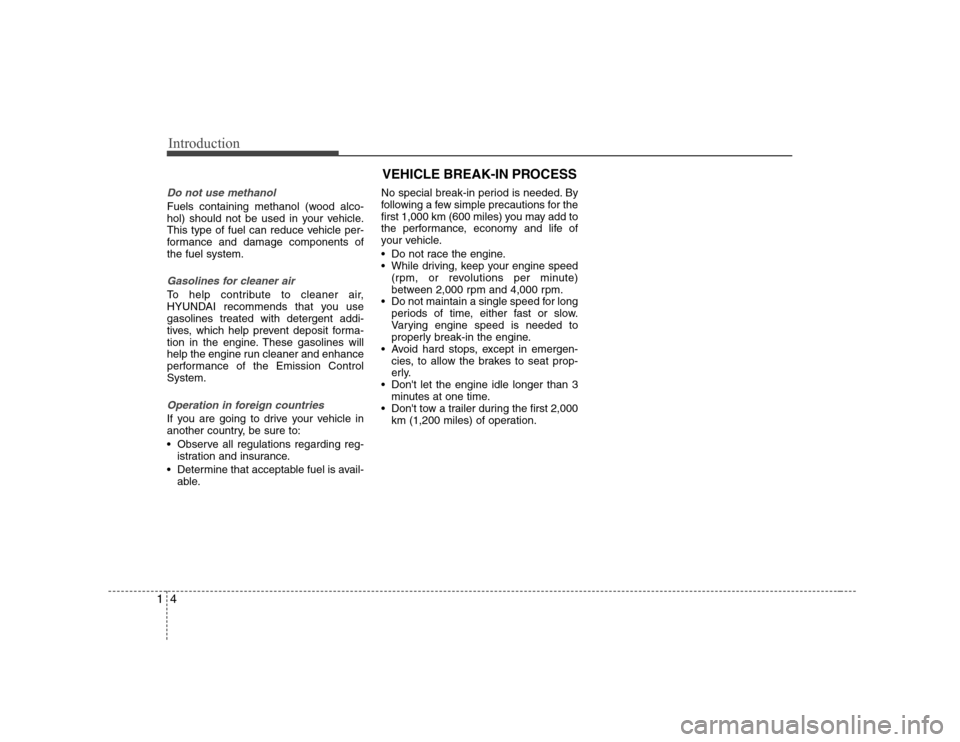
Introduction
4
1
Do not use methanol
Fuels containing methanol (wood alco-
hol) should not be used in your vehicle.
This type of fuel can reduce vehicle per-
formance and damage components ofthe fuel system.
Gasolines for cleaner air
To help contribute to cleaner air,
HYUNDAI recommends that you usegasolines treated with detergent addi-
tives, which help prevent deposit forma-
tion in the engine. These gasolines will
help the engine run cleaner and enhance
performance of the Emission ControlSystem.
Operation in foreign countries
If you are going to drive your vehicle in
another country, be sure to:
Observe all regulations regarding reg-
istration and insurance.
Determine that acceptable fuel is avail- able. No special break-in period is needed. By
following a few simple precautions for the
first 1,000 km (600 miles) you may add to
the performance, economy and life of
your vehicle.
Do not race the engine.
While driving, keep your engine speed
(rpm, or revolutions per minute)
between 2,000 rpm and 4,000 rpm.
Do not maintain a single speed for long
periods of time, either fast or slow.
Varying engine speed is needed to
properly break-in the engine.
Avoid hard stops, except in emergen- cies, to allow the brakes to seat prop-
erly.
Don't let the engine idle longer than 3
minutes at one time.
Don't tow a trailer during the first 2,000 km (1,200 miles) of operation.
VEHICLE BREAK-IN PROCESS
Page 12 of 374
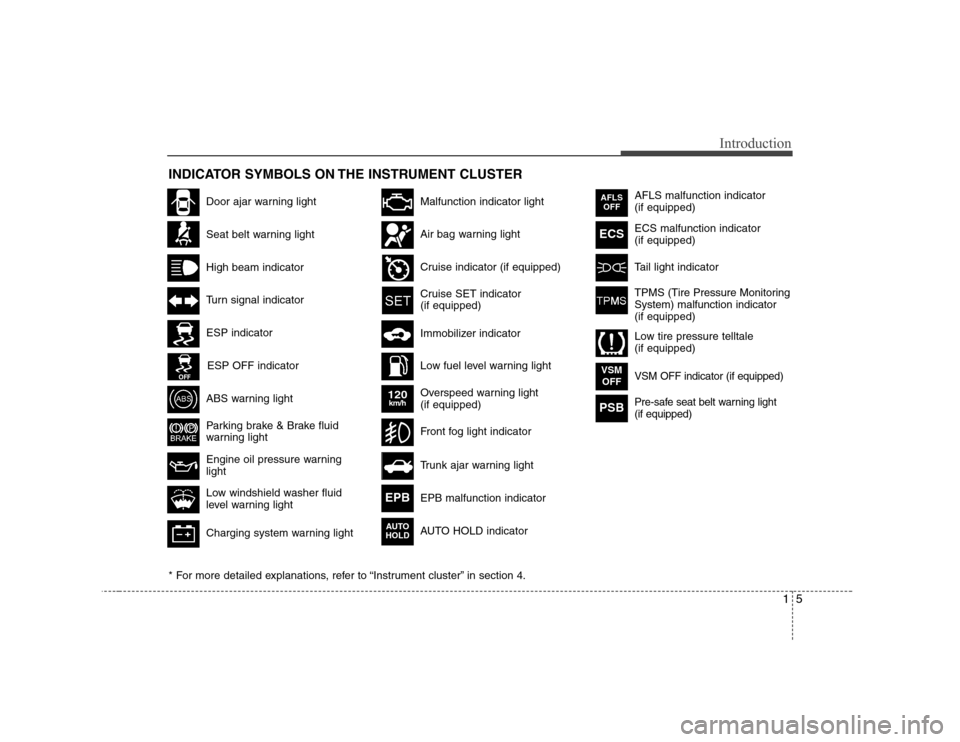
15
Introduction
INDICATOR SYMBOLS ON THE INSTRUMENT CLUSTER
Seat belt warning light
High beam indicator
Turn signal indicator
ABS warning light
Parking brake & Brake fluid
warning light
Engine oil pressure warning light
ESP indicator
ESP OFF indicator
Malfunction indicator light
Air bag warning light
Cruise indicator (if equipped)
Cruise SET indicator (if equipped)
Immobilizer indicator
Low fuel level warning light
* For more detailed explanations, refer to “Instrument cluster” in section 4.
Charging system warning light
Low windshield washer fluid
level warning light
Door ajar warning light Overspeed warning light (if equipped)
120km/h
AFLS malfunction indicator (if equipped) ECS malfunction indicator (if equipped)
Tail light indicator
Trunk ajar warning light
Front fog light indicator
AFLSOFF
ECS
EPB malfunction indicator
AUTO HOLD indicator EPB
VSM OFF indicator (if equipped)VSM
OFF
Pre-safe seat belt warning light (if equipped)PSB
AUTO
HOLD
TPMS (Tire Pressure Monitoring System) malfunction indicator(if equipped)
Low tire pressure telltale (if equipped)
Page 15 of 374
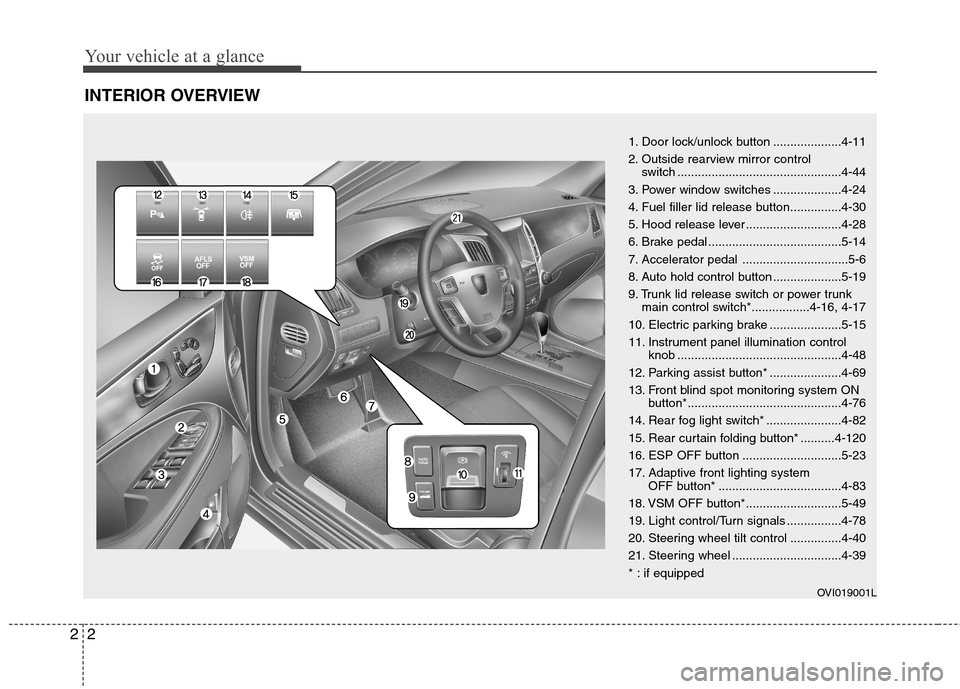
Your vehicle at a glance
2
2
INTERIOR OVERVIEW
1. Door lock/unlock button ....................4-11
2. Outside rearview mirror control
switch ................................................4-44
3. Power window switches ....................4-24
4. Fuel filler lid release button...............4-30
5. Hood release lever ............................4-28
6. Brake pedal .......................................5-14
7. Accelerator pedal ...............................5-6
8. Auto hold control button ....................5-19
9. Trunk lid release switch or power trunk main control switch*.................4-16, 4-17
10. Electric parking brake .....................5-15
11. Instrument panel illumination control knob ................................................4-48
12. Parking assist button* .....................4-69
13. Front blind spot monitoring system ON button*.............................................4-76
14. Rear fog light switch* ......................4-82
15. Rear curtain folding button* ..........4-120
16. ESP OFF button .............................5-23
17. Adaptive front lighting system OFF button* ....................................4-83
18. VSM OFF button*............................5-49
19. Light control/Turn signals ................4-78
20. Steering wheel tilt control ...............4-40
21. Steering wheel ................................4-39
* : if equipped
OVI019001L
Page 17 of 374
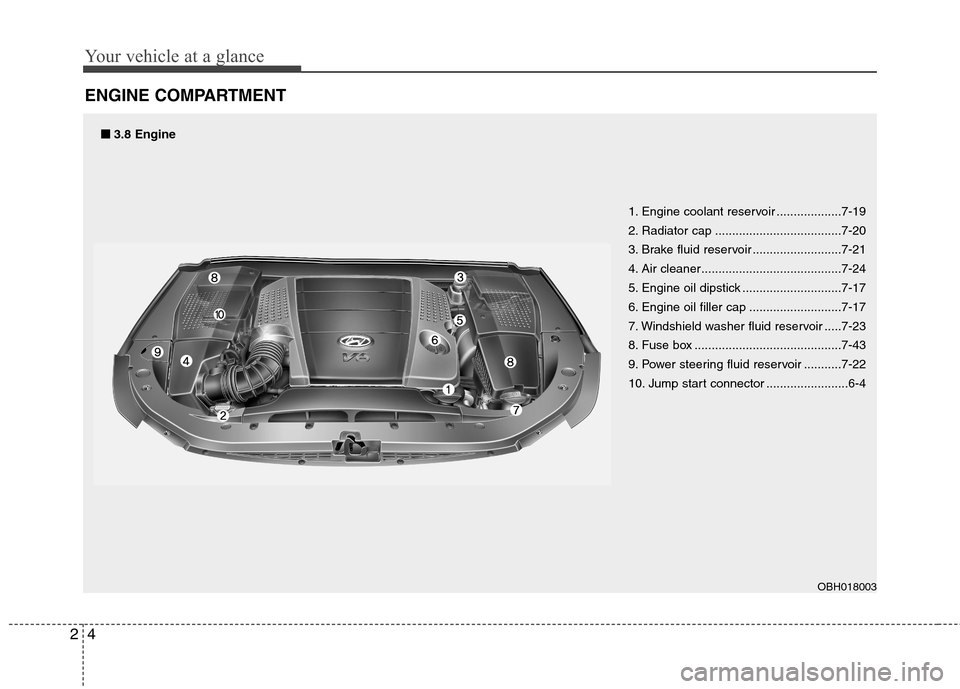
Your vehicle at a glance
4
2
ENGINE COMPARTMENT
1. Engine coolant reservoir ...................7-19
2. Radiator cap .....................................7-20
3. Brake fluid reservoir ..........................7-21
4. Air cleaner.........................................7-24
5. Engine oil dipstick .............................7-17
6. Engine oil filler cap ...........................7-17
7. Windshield washer fluid reservoir .....7-23
8. Fuse box ...........................................7-43
9. Power steering fluid reservoir ...........7-22
10. Jump start connector ........................6-4
OBH018003
■■3.8 Engine
Page 18 of 374
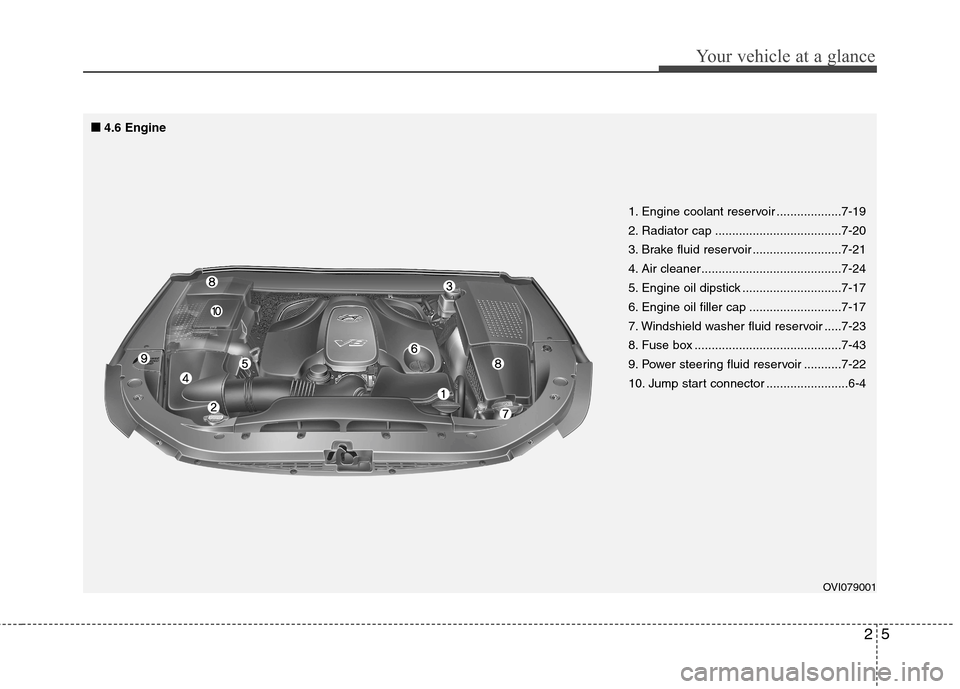
25
Your vehicle at a glance
OVI079001
1. Engine coolant reservoir ...................7-19
2. Radiator cap .....................................7-20
3. Brake fluid reservoir ..........................7-21
4. Air cleaner.........................................7-24
5. Engine oil dipstick .............................7-17
6. Engine oil filler cap ...........................7-17
7. Windshield washer fluid reservoir .....7-23
8. Fuse box ...........................................7-43
9. Power steering fluid reservoir ...........7-22
10. Jump start connector ........................6-4
■
■
4.6 Engine
Page 75 of 374
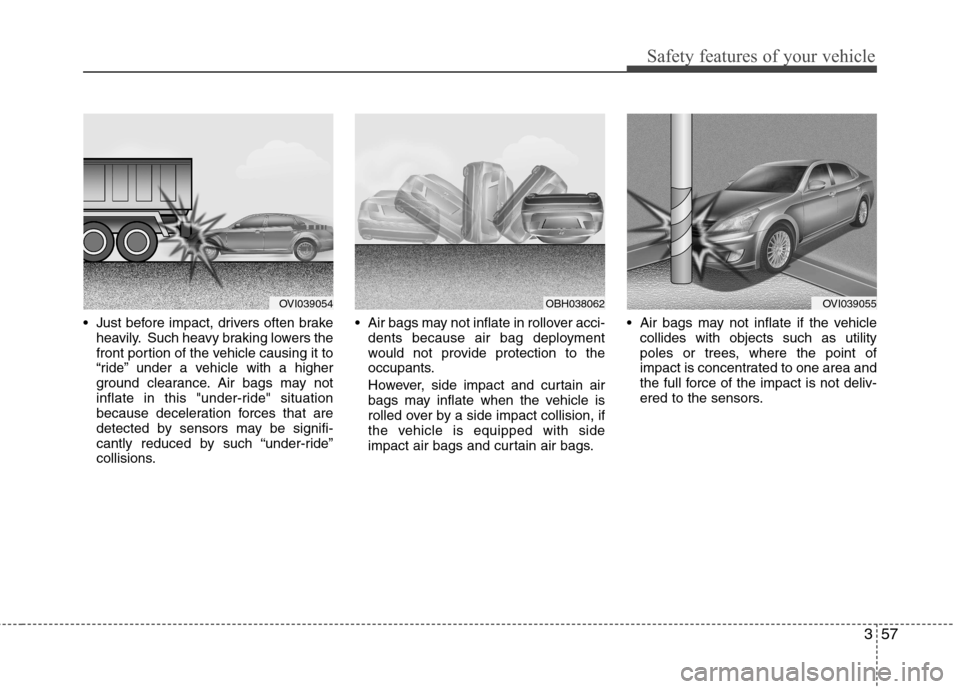
357
Safety features of your vehicle
Just before impact, drivers often brakeheavily. Such heavy braking lowers the
front portion of the vehicle causing it to
“ride” under a vehicle with a higher
ground clearance. Air bags may not
inflate in this "under-ride" situation
because deceleration forces that are
detected by sensors may be signifi-
cantly reduced by such “under-ride”
collisions. Air bags may not inflate in rollover acci-
dents because air bag deployment
would not provide protection to the
occupants.
However, side impact and curtain air bags may inflate when the vehicle is
rolled over by a side impact collision, if
the vehicle is equipped with side
impact air bags and curtain air bags. Air bags may not inflate if the vehicle
collides with objects such as utility
poles or trees, where the point of
impact is concentrated to one area and
the full force of the impact is not deliv-
ered to the sensors.
OVI039054OBH038062OVI039055
Page 89 of 374
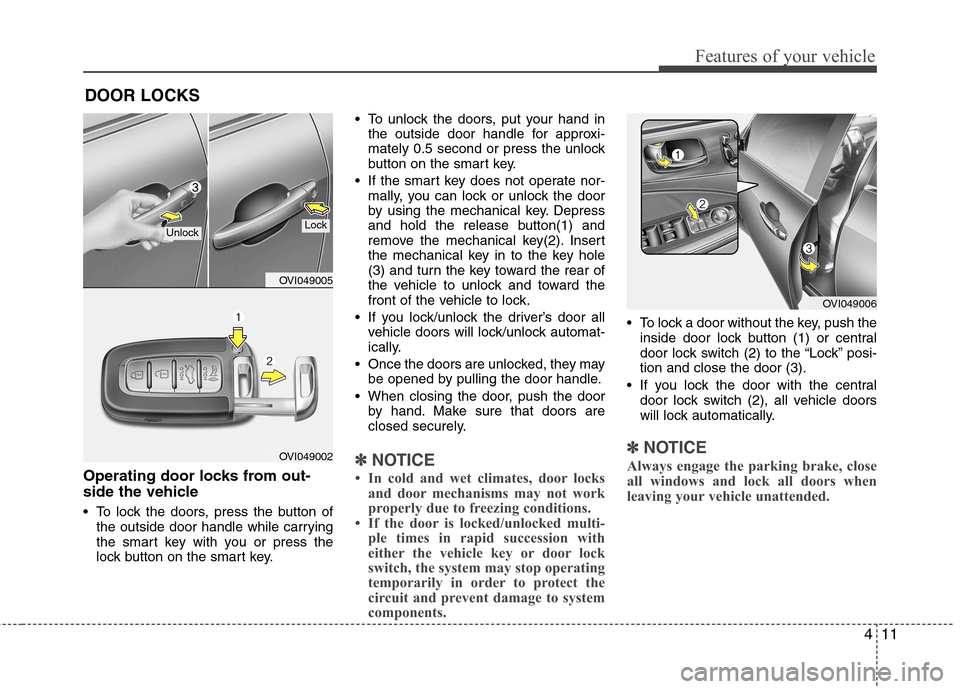
411
Features of your vehicle
Operating door locks from out-
side the vehicle
To lock the doors, press the button ofthe outside door handle while carrying
the smart key with you or press the
lock button on the smart key. To unlock the doors, put your hand in
the outside door handle for approxi-
mately 0.5 second or press the unlock
button on the smart key.
If the smart key does not operate nor- mally, you can lock or unlock the door
by using the mechanical key. Depress
and hold the release button(1) and
remove the mechanical key(2). Insert
the mechanical key in to the key hole
(3) and turn the key toward the rear of
the vehicle to unlock and toward the
front of the vehicle to lock.
If you lock/unlock the driver’s door all vehicle doors will lock/unlock automat-
ically.
Once the doors are unlocked, they may be opened by pulling the door handle.
When closing the door, push the door by hand. Make sure that doors are
closed securely.✽✽ NOTICE
In cold and wet climates, door locks and door mechanisms may not work
properly due to freezing conditions.
If the door is locked/unlocked multi-
ple times in rapid succession with
either the vehicle key or door lock
switch, the system may stop operating
temporarily in order to protect the
circuit and prevent damage to system
components.
To lock a door without the key, push the
inside door lock button (1) or central
door lock switch (2 ) to the “Lock” posi-
tion and close the door (3).
If you lock the door with the central door lock switch (2), all vehicle doors
will lock automatically.
✽✽ NOTICE
Always engage the parking brake, close
all windows and lock all doors when
leaving your vehicle unattended.
DOOR LOCKS
OVI049006
OVI049005
OVI049002
UnlockLock
Page 91 of 374
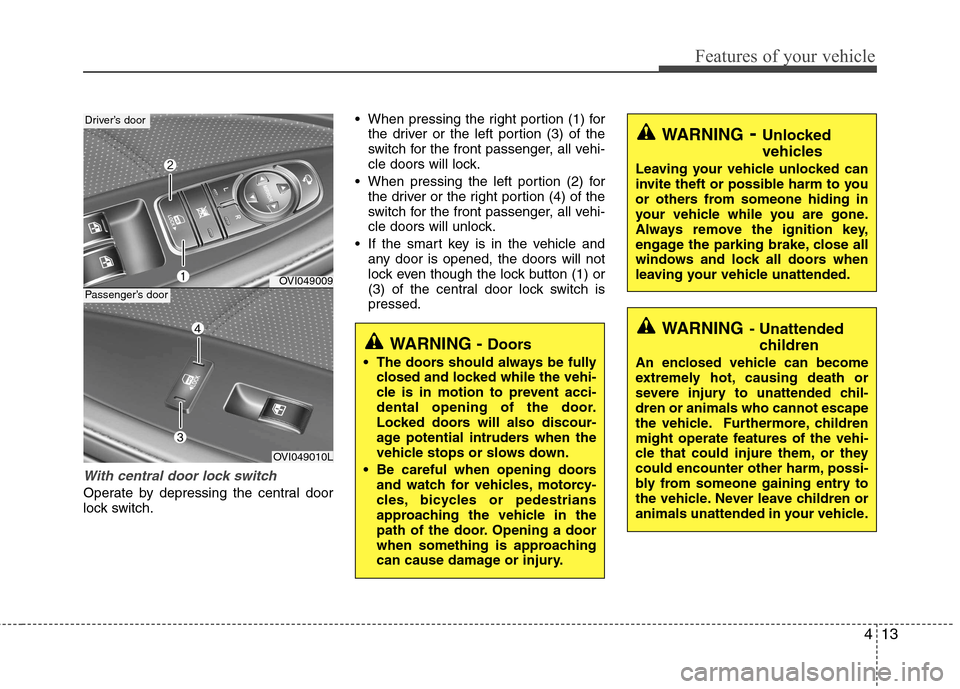
413
Features of your vehicle
With central door lock switch
Operate by depressing the central door
lock switch. When pressing the right portion (1) for
the driver or the left portion (3) of the
switch for the front passenger, all vehi-
cle doors will lock.
When pressing the left portion (2) for the driver or the right portion (4) of the
switch for the front passenger, all vehi-
cle doors will unlock.
If the smart key is in the vehicle and any door is opened, the doors will not
lock even though the lock button (1) or
(3) of the central door lock switch ispressed.
OVI049009
Driver’s door
OVI049010L
Passenger’s door
WARNING - Unlocked
vehicles
Leaving your vehicle unlocked can
invite theft or possible harm to you
or others from someone hiding in
your vehicle while you are gone.
Always remove the ignition key,
engage the parking brake, close all
windows and lock all doors when
leaving your vehicle unattended.
WARNING - Unattended
children
An enclosed vehicle can become
extremely hot, causing death or
severe injury to unattended chil-dren or animals who cannot escape
the vehicle. Furthermore, children
might operate features of the vehi-
cle that could injure them, or they
could encounter other harm, possi-
bly from someone gaining entry to
the vehicle. Never leave children or
animals unattended in your vehicle.
WARNING - Doors
The doors should always be fully closed and locked while the vehi-
cle is in motion to prevent acci-
dental opening of the door.
Locked doors will also discour-
age potential intruders when the
vehicle stops or slows down.
Be careful when opening doors and watch for vehicles, motorcy-
cles, bicycles or pedestrians
approaching the vehicle in the
path of the door. Opening a door
when something is approaching
can cause damage or injury.
Page 133 of 374
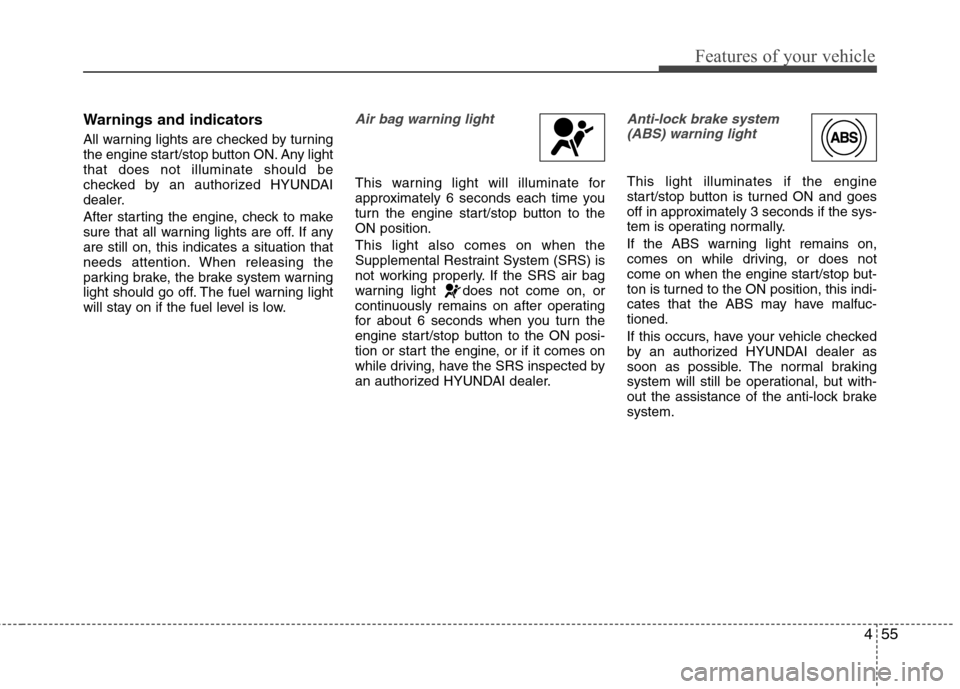
455
Features of your vehicle
Warnings and indicators
All warning lights are checked by turning
the engine start/stop button ON. Any lightthat does not illuminate should be
checked by an authorized HYUNDAI
dealer.
After starting the engine, check to make
sure that all warning lights are off. If anyare still on, this indicates a situation that
needs attention. When releasing the
parking brake, the brake system warning
light should go off. The fuel warning light
will stay on if the fuel level is low.Air bag warning light
This warning light will illuminate for
approximately 6 seconds each time you
turn the engine start/stop button to theON position. This light also comes on when the
Supplemental Restraint System (SRS) is
not working properly. If the SRS air bag
warning light does not come on, or
continuously remains on after operating
for about 6 seconds when you turn the
engine start/stop button to the ON posi-
tion or start the engine, or if it comes on
while driving, have the SRS inspected by
an authorized HYUNDAI dealer.
Anti-lock brake system(ABS) warning light
This light illuminates if the engine
start/stop button is turned ON and goes
off in approximately 3 seconds if the sys-
tem is operating normally.
If the ABS warning light remains on,
comes on while driving, or does not
come on when the engine start/stop but-
ton is turned to the ON position, this indi-
cates that the ABS may have malfuc-tioned.
If this occurs, have your vehicle checked
by an authorized HYUNDAI dealer as
soon as possible. The normal braking
system will still be operational, but with-
out the assistance of the anti-lock brakesystem.
Page 134 of 374
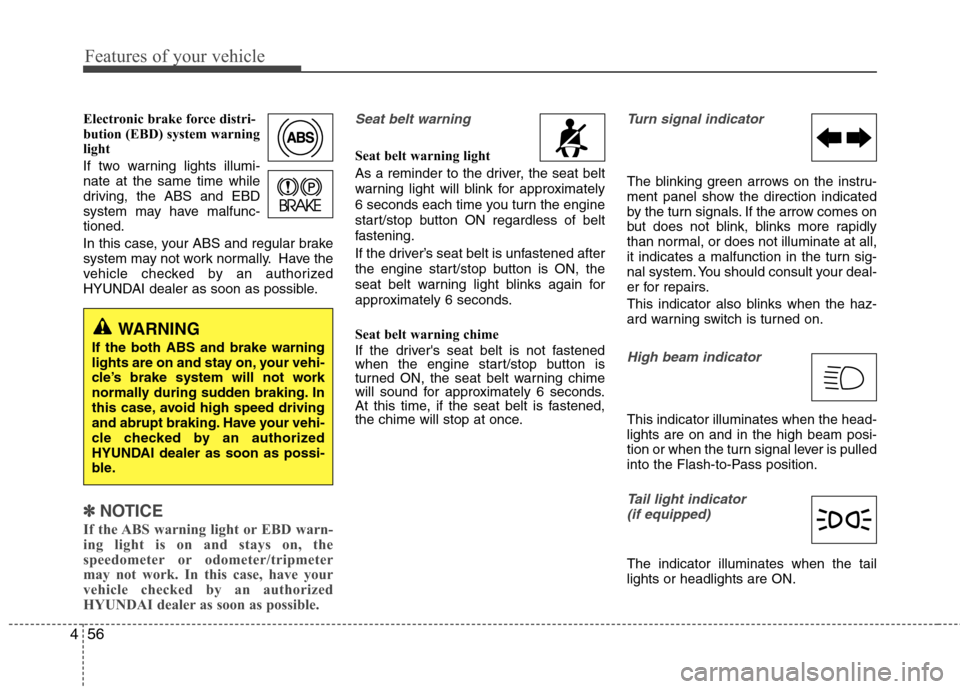
Features of your vehicle
56
4
Electronic brake force distri-
bution (EBD) system warning
light
If two warning lights illumi- nate at the same time while
driving, the ABS and EBD
system may have malfunc-tioned.
In this case, your ABS and regular brake
system may not work normally. Have the
vehicle checked by an authorized
HYUNDAI dealer as soon as possible.
✽✽
NOTICE
If the ABS warning light or EBD warn-
ing light is on and stays on, the
speedometer or odometer/tripmeter
may not work. In this case, have your
vehicle checked by an authorized
HYUNDAI dealer as soon as possible.
Seat belt warning
Seat belt warning light
As a reminder to the driver, the seat belt
warning light will blink for approximately
6 seconds each time you turn the engine
start/stop button ON regardless of belt
fastening.
If the driver’s seat belt is unfastened after
the engine start/stop button is ON, the
seat belt warning light blinks again for
approximately 6 seconds.
Seat belt warning chime
If the driver's seat belt is not fastened
when the engine start/stop button is
turned ON, the seat belt warning chime
will sound for approximately 6 seconds.
At this time, if the seat belt is fastened,
the chime will stop at once.
Turn signal indicator
The blinking green arrows on the instru-
ment panel show the direction indicated
by the turn signals. If the arrow comes on
but does not blink, blinks more rapidly
than normal, or does not illuminate at all,
it indicates a malfunction in the turn sig-
nal system. You should consult your deal-
er for repairs.
This indicator also blinks when the haz-
ard warning switch is turned on.
High beam indicator
This indicator illuminates when the head- lights are on and in the high beam posi-
tion or when the turn signal lever is pulled
into the Flash-to-Pass position.
Tail light indicator (if equipped)
The indicator illuminates when the tail lights or headlights are ON.
WARNING
If the both ABS and brake warning
lights are on and stay on, your vehi-
cle’s brake system will not work
normally during sudden braking. In
this case, avoid high speed driving
and abrupt braking. Have your vehi-
cle checked by an authorized
HYUNDAI dealer as soon as possi-
ble.